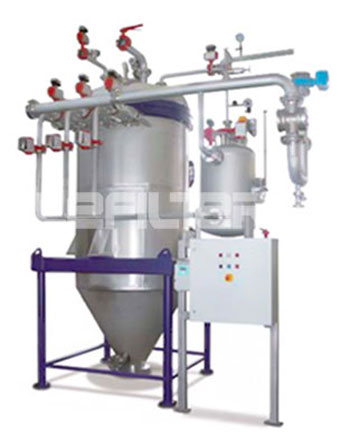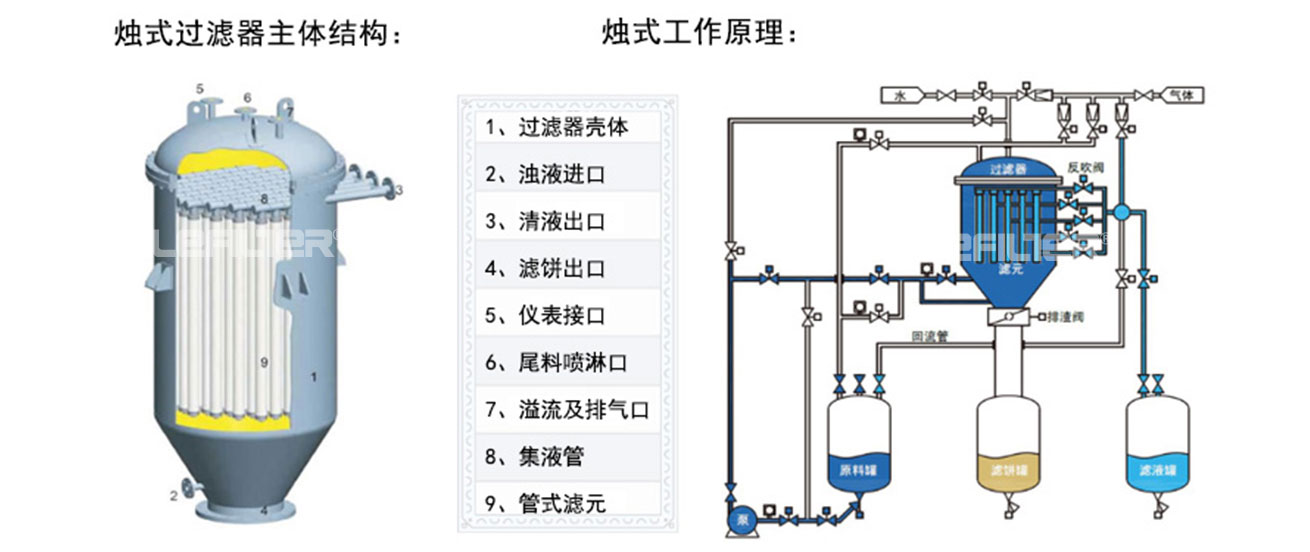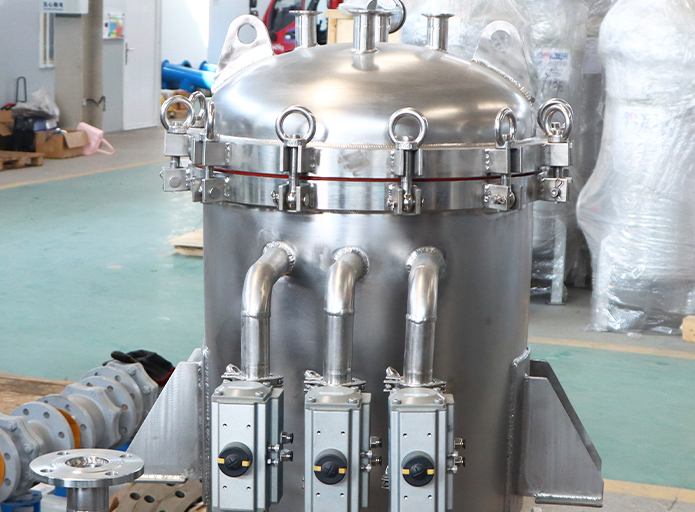First of all, I am very happy to have the opportunity to introduce to you the application of fully automatic candle filter in the mining field and its importance. The fully automatic candle filter is a powerful and efficient solid-liquid separation equipment, which is widely used and critical in the mining field.
During mineral processing, large amounts of solids and liquids need to be effectively separated to ensure product purity and process efficiency. This is where fully automatic candle filters come into play. It uses specially designed filter candles to perform fine filtration work. Due to its automated cleaning and discharge functions, it can greatly improve filtration efficiency while reducing labor and maintenance costs.
The advantage of a fully automatic candle filter is its ability to handle large volumes of liquids containing solid particles while maintaining extremely high filtration accuracy. This enables it to achieve excellent results when treating solid-liquid mixtures produced in mining processes such as flotation wastewater and tailings wastewater.
This filter helps improve the quality of wastewater after ore treatment, making it more environmentally friendly and in compliance with strict environmental regulations. This is because the fully automatic candle filter can effectively remove suspended solids and further reduce the heavy metal content in the treated wastewater.
The use of fully automatic candle filters in mining can not only improve solid-liquid separation efficiency and improve water quality, but also save manpower and material resources, reduce operating costs, and help enterprises comply with environmental protection regulations. It is a very cost-effective and efficient equipment. .

Fully automatic candle filters have become the core equipment of solid-liquid separation technology due to their high efficiency, reliability and automation. The working principle includes three key steps: filtration, backwashing, and mud discharge. It automates and optimizes complex filtration tasks, making solid-liquid separation in the production process simple and efficient.
Filtering stage:
The filtration stage is the first step in how a filter works. At this stage, the mixture first enters the filter. The mixed liquid flows into the filter through the inlet, and is driven by a certain pressure and begins to pass through the filter candles covered with countless tiny holes, and these filter candles constitute the main filter element of the filter. During the process of flowing through the holes, the solid particles in the liquid are intercepted by the surface of the filter candle, and the pure liquid enters the interior of the candle body through the filter holes, and finally flows out from the outlet. Through this process, preliminary separation of liquid and solid is achieved.
Backwash stage:
As more and more solid particles are captured on the surface of the filter candle, the filter surface will be gradually blocked, causing the filter resistance to gradually increase. At this time, backwashing is required. According to the preset pressure difference or timing conditions, the control device will automatically start the backwash process. During the backwash process, the equipment will press clean backwash fluid into the interior of the filter candle through the backwash pump, and the backwash fluid will wash away the surface of the filter candle in reverse direction, flushing out the solid particles attached to it. This step is crucial for the normal operation of the equipment. The backwashing process cleans the filter surface so that the equipment can perform a new round of high-efficiency filtration again.
Mud removal stage:
The solid residue in the cleaning fluid forms a slurry that collects at the bottom of the candle filter. When the solid particles reach a certain amount, the filter will automatically discharge mud. In this process, the mud at the bottom is discharged from the filter by opening the mud discharge valve to ensure the normal operation of the filter and thereby ensure the filtration effect.
In summary, the fully automatic candle filter achieves fully automated and continuous operation from filtration, cleaning to mud discharge through exquisite design and intelligent control system. This greatly improves production efficiency and product quality, allowing users to obtain satisfactory solid-liquid separation results without manual intervention. This is the general working principle and process of the fully automatic candle filter.
As an efficient solid-liquid separation equipment, the fully automatic candle filter has been widely used in modern industrial production, especially in mining, chemical industry, food processing, pharmaceutical and other industries. Its main advantages are as follows:
High degree of automation: Full automation means that the filter has independent system control and can automatically complete the entire process of filtration, cleaning, and mud discharge. This undoubtedly reduces the error rate of manual operations during the work process and improves efficiency. Minimizing manual intervention allows companies to deploy fewer manpower to maintain and operate the filtration system, which not only saves human resources, but also reduces equipment damage caused by improper operation and extends the service life of the equipment.
Efficient solid-liquid separation: The candle filter element has an excellent filtration effect and can efficiently filter out solid particles in the liquid to ensure the purity of the final output liquid. This has greatly improved the quality of industrially produced products and greatly reduced the impact of waste water and exhaust gas on the environment, reflecting the company's emphasis on environmental protection.
Economical operating costs: In addition to the cost of equipment purchase, the energy consumption and maintenance costs required for operation of the fully automatic candle filter can be controlled within a low range. Furthermore, since manual participation is reduced to a large extent, labor costs are greatly reduced, making the fully automatic candle filter highly economical in the long run.
Large processing capacity: This filtration equipment can be used in large-scale production lines. Its processing capacity can meet the needs of large-scale industrial equipment and meet the continuous and large-scale solid-liquid separation needs of the production line, thereby achieving efficient production.
Powerful environmental protection function: The fully automatic candle filter not only separates solid and liquid, but also has obvious environmental protection effect. Through its precise separation process, it can effectively remove suspended solids and certain harmful substances in wastewater, reducing environmental pollution caused by industrial production.
Long service life and good stability: Because the materials selected for the fully automatic candle filter are durable and corrosion-resistant, with correct use and maintenance, this filter has a long service life. Moreover, because its operation is relatively simple and requires less manual intervention, the operation process is stable and the failure rate is relatively low.
Combined with the above characteristics, the fully automatic candle filter has shown significant advantages in real-life applications and can meet the needs of different industries and enterprises of different sizes, providing high efficiency, low cost and environmentally friendly solid-liquid separation solutions.

The fully automatic candle filter is a complex device, and its operation and functionality undoubtedly depend on the design of its structure. Below, I will describe the main structural components of the fully automatic candle filter in as much detail as possible:
Candle filter element: This is the core part of the fully automatic candle filter and the main execution component of the filtration operation. Candle filter elements usually consist of several parts, including a central tube, a candle filter media and a support body. The central tube is the path for the liquid to flow out after the solid particles and liquid are separated. The candle-shaped filter media is usually made of multiple layers of special materials and can filter out solid particles as small as microns on demand. The role of the support is to keep the candle The shape and stability of the filter media prevent the filter media from deforming under the pressure of liquid flow.
Filter housing: The filter housing is the "shell" of the candle filter element and other parts. It is usually made of high-quality stainless steel or other corrosion-resistant materials to ensure its durability in various environments and working conditions. and security. The shell is designed to be closed and can operate under a certain pressure, so that the input mixture is forced to pass through the candle filter element under the action of pressure, thereby increasing the filtration efficiency.
Control system: The control system is the key to the automatic operation of the fully automatic candle filter. It receives parameters set by the operator, such as filtering pressure difference, flow rate, time, etc., and controls various operating states of the filter based on these parameters, including starting or stopping filtration, backwashing, mud discharge, etc. The control system of modern fully automatic candle filters usually uses advanced computer control, making its work more precise and its operating status easier to predict.
Backwash pump and mud discharge valve: These two parts are key equipment for cleaning and mud discharge of the fully automatic candle filter. During the filtration operation, the surface of the candle filter element will gradually be attached and blocked by solid particles. At this time, the backwash pump will start to push the cleaning liquid through the filter element in the reverse direction, flushing the solid particles from the filter element. , to achieve the purpose of cleaning. When the solid particles accumulated in the shell reach a certain level, the mud discharge valve will automatically open to discharge the solid particles.
Other accessories: Fully automatic candle filters may also include some other accessories, such as pressure gauges, flow meters, temperature sensors, etc., which are used to monitor and control the operating status of the filter, ensure the normal operation of the filter, and improve filtration efficiency.
The above depicts the basic structural components of a fully automatic candle filter, but please note that different brands and models of fully automatic candle filters may be different, which is also the result of adjustments by equipment designers based on specific needs.
The filter housing of the fully automatic candle filter is a very important component. It provides a stable, airtight and safe environment for the candle filter element, control system, backwash pump and mud valve inside the filter. external surrounding environment. The selection and construction materials of the housing are closely related to its operating performance and durability.
Commonly used manufacturing materials for filter housings are mainly high-quality stainless steel. Stainless steel is a very corrosion-resistant material that will not be damaged by handling a variety of liquids of different properties, such as acidic, alkaline, etc., and maintains good stability. In addition, there are many kinds of stainless steel profiles, such as 304, 316L, etc., each with its own unique properties and advantages, which can be selected according to the actual application situation.
In addition to stainless steel, sometimes other materials with strong corrosion resistance and affordable cost may be selected to make the filter housing, such as aluminum alloy, titanium alloy, or even composite materials. These materials offer excellent weather and corrosion resistance, maintaining their stability and reliability even in extremely harsh environments.
However, it is worth noting that the choice of materials for the housing does not only depend on the characteristics of the materials themselves, but also takes into account the environment in which the filter is used, the nature of the fluid being processed, and economic factors.
For example, when the application environment involves high temperature, high pressure or highly corrosive scenarios, the types of liquids to be processed are also more diverse, which may include strong acids, strong alkali, solvents, etc., which requires the shell material to have higher resistance. Corrosion resistance, heat resistance and pressure resistance.
Economic factors are also an important aspect that must be considered when considering manufacturing materials. Although choosing high-quality materials can ensure the performance and life of the filter, it is undoubtedly a wiser choice to choose lower-cost materials while ensuring performance. Therefore, manufacturers often need to find a balance between these factors to achieve both economical and reliable filter manufacturing.
Therefore, the selection of housing materials for fully automatic candle filters is by no means a simple matter. Designers and manufacturers need to choose the most appropriate material based on various factors such as specific application scenarios, the nature of the fluid being processed, and budget. To make the casing.

When selecting the appropriate filter housing material, the following factors must be fully considered to ensure that while meeting performance requirements, cost and life span are also taken into consideration.
Corrosiveness: Filter housings often need to handle various corrosive liquids, including various acids, alkalis, salts, etc. Therefore, the housing material needs to have good corrosion resistance. For some special liquids, such as those containing special chemicals or solvents, shell materials with special anti-corrosion capabilities may be required. Among them, stainless steel is a commonly used corrosion-resistant material that can be used to manufacture various types of filter housings. In addition, more corrosion-resistant materials such as Hastelloy can be used to handle more complex fluids. When considering corrosion, it is also necessary to consider the corrosion performance of the shell material under different temperature and pressure conditions, because some materials may show stronger corrosion under specific conditions.
Temperature and pressure: The filter may need to work in different temperature and pressure environments during operation. At this time, the shell material needs to have corresponding temperature and pressure tolerance. For high-temperature environments, it is necessary to select materials that can withstand high temperatures without causing performance degradation and shortened life. At the same time, the toughness and cold brittleness resistance of the material must be considered when working in extremely cold environments. For pressure, the shell material needs to have enough strength and toughness to withstand normal operating pressure and remain stable even under sudden pressure increases.
Economical: Although we want to choose materials with the best performance, we also need to take price into consideration due to cost factors. The material selection of the casing needs to be carried out within the investment budget, seeking a balance between reasonable price and excellent performance. In addition, possible additional costs such as maintenance and replacement in the future should also be considered, so the durability and maintainability of the material are also necessary considerations.
Processability: In addition, the processability of the housing material is also very important. Good processability makes the housing manufacturing process easier and reduces costs. The most common processing methods usually include cutting, welding, forging, molding, etc., and the selected shell material needs to be able to adapt to these processing methods.
Compatibility: Many different materials may be used in filters, so the housing materials need to be compatible. There must be no adverse chemical reactions between materials in contact with each other, or a reduction in material performance due to a mismatch in physical properties.
Environmental protection and regulatory requirements: With the increasing awareness of environmental protection, more filters need to use environmentally friendly shell materials. These materials do not produce hazardous waste during their manufacture and use, or the waste can be further processed and utilized. In addition, local and industry regulations regarding filter housing material requirements need to be taken into consideration. For example, in special industries such as food manufacturing and pharmaceutical manufacturing, shell materials need to meet relevant food-grade and pharmaceutical-grade requirements.
In general, the selection of filter housing materials requires comprehensive consideration of the above-mentioned factors. According to the actual use environment and process conditions, combined with the performance requirements and cost budget of the equipment, comprehensive consideration from multiple angles can be used to select the most suitable shell material.








